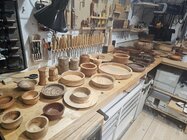nothing definitive or specific about a general plan to price.
Yeah. See there's so much variation. It boils down to what the market will bear.
From simple stuff like the wood (rarity, figure, color, etc), embellishments, stuff like that.
For bowls there's also intended use (salad bowls, cereal bowls, change/key bowls, decorative platters, etc)
Then we get into things like quality - how's the form, finish, and all that.
You may also need to factor in how well known are you (locally and/or regionally and/or wider).
And what sort of venue are you selling at - flea market vs craft fair vs art show vs gallery - or anything in between.
Location also plays into it - someone in Jackson Hole will probably be able to charge more for the same item than in, say, Shreveport.
Similarly time of year may be a factor (holidays, tourist season, etc)
And the general economy (or people's feeling about the economy).
Your W x H x ? is what most turners probably start with.
Visit markets where you're planning to sell (and similar ones). Look at what other turners are charging, try to work out their "? factor". Also look at prices on everything else hand-made - that'll give you an idea of what the customers are expecting.
I'd go ahead and start with what you're thinking and see how that goes. After that, it's just experience. If you sell out of everything, your prices were too low.
I personally now go mostly on "gut feel" based on past sales etc. Couldn't tell you what my "? factor" is...

